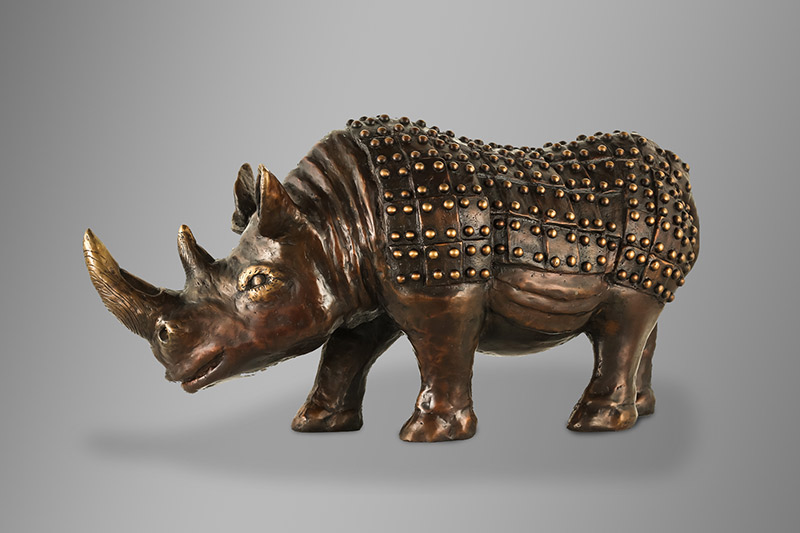
Armor Suit Rhino | 金縷衣
| 語音導覽 | 青銅 60 x 20 x28cm |
《金縷衣》一詞源於中唐時期杜秋娘所作之七言絕句,反復吟唱莫負好時光,情感單純而強烈,令人印象深刻傳唱千古。若以此意觀之,藝術家施力仁的最新創作《金縷衣》則創新大膽,金蝟刺、甲 片,靈獸犀牛身著一席象徵尊容典雅的華袍,緩步於前。它不急不徐、遊刃有餘的神色,似乎引動著千年傳唱的當代新意,即將緩步被揭示。
將歷史題材由舊翻新並賦予現代詮釋向來是施力仁的得意手法,此次嘗試將東方古典文學語彙援引進入當代雕塑,作品與提名相輔相映的堆疊效果,使得觀者在映入眼簾時,心中情難自禁地無聲吟誦杜秋娘「勸君惜取少年時」的詠歎。而犀牛自信的微笑,動靜做作之間宛若 若人生於鼓掌,淩風顧盼的神態,又有何良辰易逝、韶華難留之歎?
此新作有別於施力仁以往威武、拔山蓋世的風格,戴盡黃金甲的《金縷衣》步態輕盈矯健,趨前的右腿,弧形背脊,行走姿態猶如流動之風,帶有目的性的步伐宛若即將通往藝術的永恆之境。滿是刺蝟圓柱的質地,令人聯想秦始皇陵陵園的兵馬陣,居於陣式的正中央的重裝兵馬俑,是最強身力健的一支隊伍,他們身披的鎧甲、肩墊等護身之物,與《金縷衣》或有相似之處:古時慣有使用犀牛皮製作軍用鎧甲的舊習,藝術家讓犀牛重新披上(犀牛鎧甲),或是展現藝術之中,仍然帶有保育,人性必須自檢自持的省思。
Shih Li-Jen has a talent for updating historical themes with a modern twist, and the "Armor suit Rhino" is a prime example. The sculpture seamlessly blends classical vocabulary from Eastern literature with contemporary art, creating a beautiful overlapping effect that complements the artwork's theme. As viewers gaze upon the sculpture's confident smile and graceful movements, they silently recite Du Qiuniang's verse, "I urge you to cherish your youth." The rhinoceros' purposeful steps serve as a reminder of the fleeting nature of time and the importance of living in the moment.
The "Armor suit Rhino" marks a departure from Shih Li-Jen's usual style of creating imposing and awe-inspiring sculptures. This artwork is light and agile, with a curved spine and a walking posture that resembles flowing wind. The sculpture's texture, with its cylindrical hedgehog quills, brings to mind the military formation of the Terracotta Army in Emperor Qin Shi Huang's tomb. The heavily armed infantry in the center of the formation was the strongest and most robust troops, bearing some resemblance to the "Armor suit Rhino." In ancient times, rhinoceros skin was commonly used to make military armor, and the artist's use of rhinoceros armor in this artwork serves as a reminder of the importance of conservation and self-reflection in human nature.